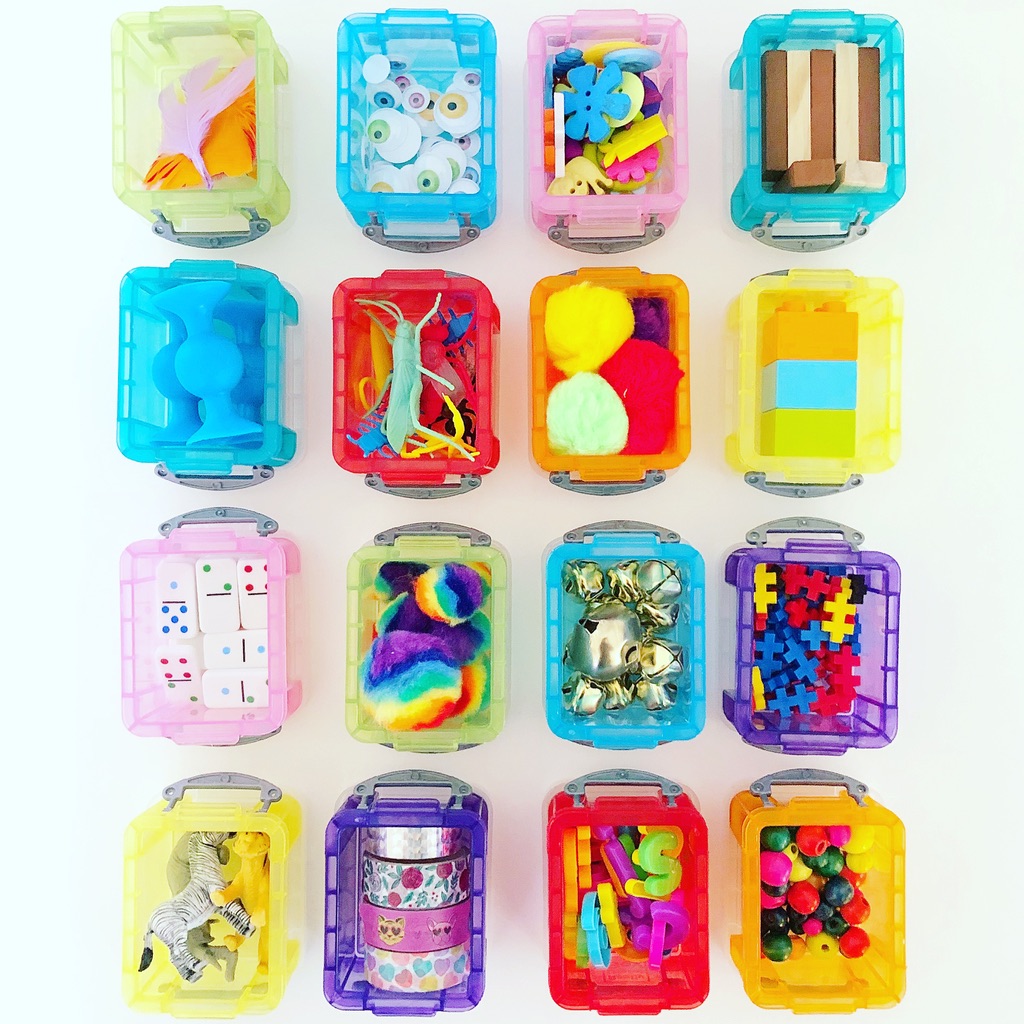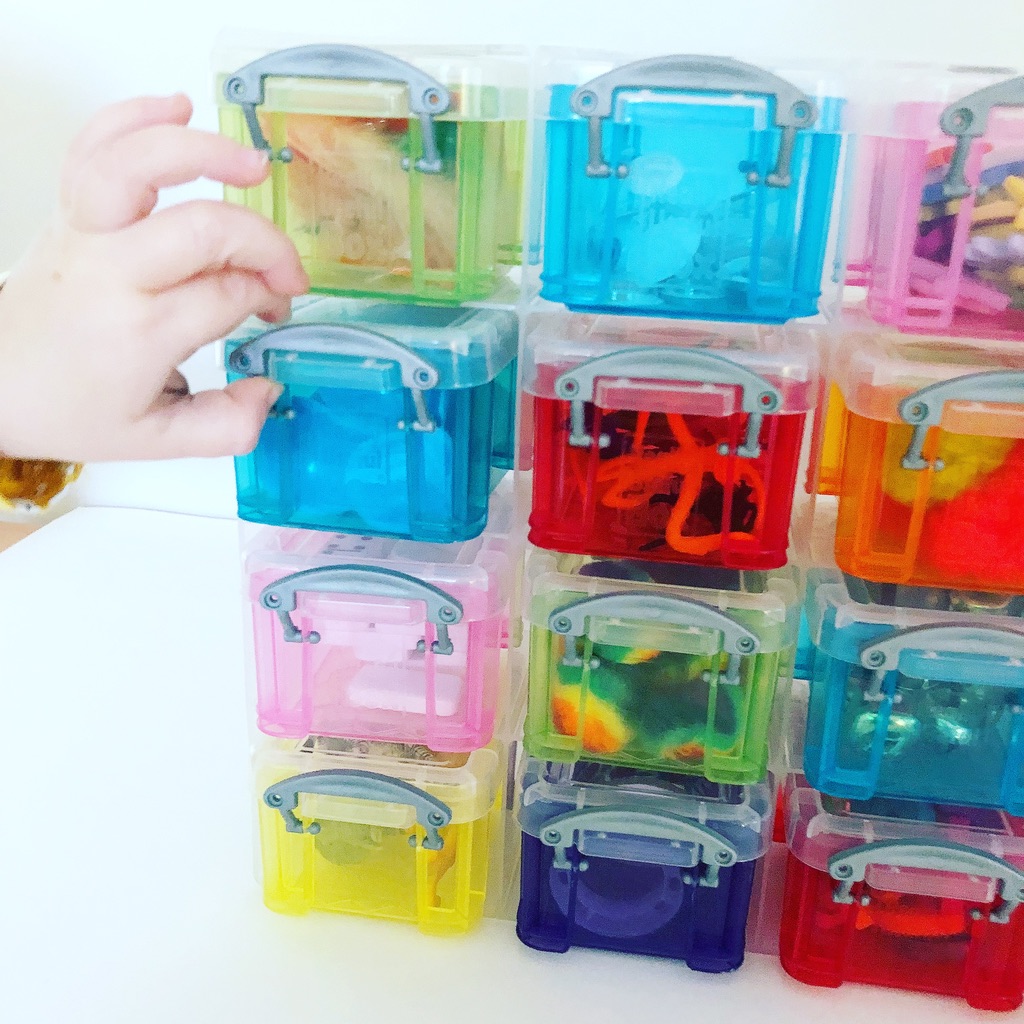Give your toddler a fun head start by making cute and colorful tinker boxes for them! They are great for encouraging STEM learning and sensory play even at a young age.
PLEASE USE YOUR BEST JUDGEMENT WITH REGARDS TO MATERIALS BEING A CHOKING HAZARD. ALWAYS BE FULLY PRESENT FOR PLAY AND AVOID SMALL MATERIALS IF YOUR CHILD STILL LIKES TO PUT THINGS IN THEIR MOUTH. NEVER LEAVE UNATTENDED AND STORE OUT OF REACH.
I came up with this idea when my daughter was 18 months. She was constantly getting into all the craft supply boxes and wanting to be hands-on with the materials. 5 year old big bro has STEM tinker trays so I figured why can't baby sis?! She is now nearly 2 years old and we still use these several time a week!
What do I need?
- a storage system- we used the Really Useful Boxes 16-box Organizer from Michael's, currently $14.99
- a fun selection of materials to tinker with (we used mostly arts and craft supplies and Dollar Tree purchases)
- a fun selection of materials to tinker with (we used mostly arts and craft supplies and Dollar Tree purchases)
What do I put in the tinker boxes?
It's worth mentioning again to be very aware of choking hazards. Be certain that your child can handle the materials you include safely, and of course always be present during the play.
Pretty much anything can go in the boxes. When we filled ours, we raided the toy room and arts and crafts cupboard to see what we could find. The Dollar Store and Target are great places to shop for fillers as well.
Include a range of textures, sizes and colors. Also work with your toddler's interests. If they love animals, include them, if they love cars, put one in a box! Offering familiarity will only help to further build engagement! My little girl went straight for the bug box!
Be sure to not fill the boxes to the brim. You know what toddlers are like with spillages! Plus in some cases, less is more and they will do better if they are not overwhelmed.
What is a tinker box?
A tinker box is simply a fancy name for a container with materials inside which kids can use to create, build, invent, learn and even just play with. After all, play is the best way for our kids to learn! Tinker boxes can be used one at a time, or for added challenge why not combine them?!
Why should I bother to make Toddler Tinker Boxes?
Providing your toddler with open-ended play materials is crucial for their learning and confidence. By offering a range of materials in small quantities, you are exposing your toddler to sensory learning, fine motor skill development, problem solving, vocabulary development, and most importantly, fun play opportunities! Just because kids are younger, it doesn't mean they can't handle a tinker tray like older kids do. It just means it needs to be adapted for them.
How do tinker boxes encourage STEM learning?
As you'll see from the photos, simply presenting a range of materials to a toddler prompts an enormous amount of independent exploration and play based learning. With baby sis it prompted conversations about animal habitats, balance, textures, colors and so much more.
Loose parts like pom poms and beads are also excellent fine motor and Math manipulatives to help teach basics like counting and grouping!
Another important thing to note is that it is ok to have several boxes open at a time. Opening all the boxes and dumping them on the floor is not so ideal! So maybe set a rule of 3 boxes open at a time, you could even select the boxes and take them to another room or place them on a tray if that will help your toddler to stay focused.
What activities can we do with the tinker boxes?
For us the biggest use of the boxes has been for simple child-led play. When baby sis was 18 months she was so happy to simply be transferring the materials in and out of the containers!
Beyond that, I also sometimes set up simple activities such as lining buttons up on washi tape, using the Squigz and pom poms or bells for balancing and counting, and combining the Dollar Tree blocks and animals to make 'jungle bridges'.
Most importantly these Toddler Tinker Boxes are simply for fun play based learning. Presenting a range of materials in small quantities is sure to get your little one hands-on and passionate about play!














No comments :
Post a Comment